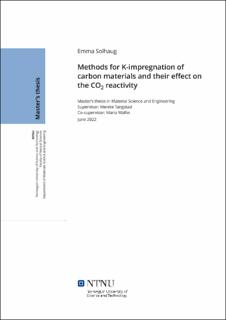| dc.contributor.advisor | Tangstad, Merete | |
| dc.contributor.advisor | Wallin, Maria | |
| dc.contributor.author | Solhaug, Emma | |
| dc.date.accessioned | 2022-10-29T17:19:44Z | |
| dc.date.available | 2022-10-29T17:19:44Z | |
| dc.date.issued | 2022 | |
| dc.identifier | no.ntnu:inspera:108217718:37271690 | |
| dc.identifier.uri | https://hdl.handle.net/11250/3028961 | |
| dc.description.abstract | En veldig stor andel av det norske CO2utslippet kommer som en følge av bruk av fossile karbon materialer i metall produksjon. I den norske mangan (Mn) produksjonen er koks mest brukt til å redusere manganmalmen. Denne masteroppgaven ser på trekull som en mulig fornybar karbon-kilde til å erstatte koks. En utfordring med å erstatte koks med trekull er at materialene har flere ulike egenskaper som vil påvirke driften av ovnen under produksjon. Denne oppgaven studerer karbon materialenes CO2 reaktivitet og hvordan reaktiviteten blir påvirket av kaliumet som finner sted inne i ovnen.
Den eksperimentelle delen av arbeidet er basert på to impregnerings metoder for å øke innholdet av kalium i karbon materialene. De to metodene er gass K-impregnering og våt K-impregnering. Begge metodene resulterte i at karbon materialene fikk økt kalium innhold, og innholdet økte mest hos våt K-impregnering. Det høyeste kalium innholdet ble oppnådd ved å bruke en 5 molar løsning i våt impregneringen med resulterende 8.71 og 10.53 %K2O. Alle prøvene ble etterhvert både analysert i SEM og CT, hvor flere forskjeller mellom kalium partiklene på prøvene ble funnet. Disse forskjellene ble vist til å ikke påvirke CO2 reaktiviteten i materialene. Til slutt ble CO2 reaktiviteten på de impregnerte materialene målt, og viste at det var en økning i kalium innholdet for alle de ulike karbon materialene. For de materialene med over 3.5 %K2O, stabiliserte CO2 reaktiviteten for alle de ulike karbon materialene seg på verdier mellom 0.030 og 0.045 %FixC/s. I praksis vil dette bety at for kalium verdiene som finnes inne i Mn-ovnen, vil både koks og trekull reagere med CO2 med nesten lik hastighet. Noe som igjen vil gjøre de andre material egenskapene viktige å studere når det kommer til et eventuelt bytte fra koks til trekull som reduktant i Mn-produksjonen. | |
| dc.description.abstract | A large part of the Norwegian CO2 emissions comes from fossil carbon sources used as reduction materials in the metallurgical industry. In the Norwegian manganese alloy production, coke is the most used carbon material for reducing the manganese ores. This thesis considers charcoal as a possible renewable substitute for coke. In earlier research it were found that there are several differing material properties between the two carbon materials, and this thesis studies the effect of the potassium present in the Mn-production and how the potassium affects the CO2 reactivity of the carbon materials.
The experimental work in this thesis is based on two methods for increasing the potassium content in the carbon materials; gas K-impregnation and wet K-impregnation. Both methods resulted in increased potassium content compared to the raw materials, but the wet K-impregnation increased the potassium content the most with 8.71 and 10.53 %K2O for impregnating using 5 molar solution. Later the samples were studied using SEM and CT, where several differences with the placement and size of the potassium particles were found. It turned out that the differences did not affect the CO2 reactivity of the samples. For all the impregnated samples the CO2 reactivity increased, and for the potassium levels above 3.5 %K2O there is found that the CO2 reactivity for all the carbon materials were between 0.030 to 0.045 %FixC/s. This means that both coke and charcoal will react with CO2 with almost the same rate, which will make other material properties be more important when studying a change from coke to charcoal for the manganese production. | |
| dc.language | eng | |
| dc.publisher | NTNU | |
| dc.title | Methods for K-impregnation of carbon materials and their effect on the CO2 reactivity | |
| dc.type | Master thesis | |
